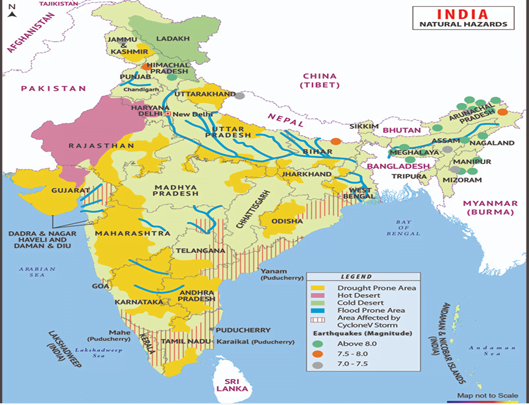Governance
Context: The National Disaster Management Authority (NDMA) received the final inputs on the draft of India’s first national policy for the mitigation and rehabilitation of the people affected by river and coastal erosion.
- The Union Ministry of Home Affairs has directed NDMA to draft a policy based on the 15th Finance Commission’s report.
About Disaster and its classification:
- Disaster is an undesirable catastrophe resulting from the forces that are largely beyond human control, strikes quickly with little or no warning, and causes or threatens serious disruption of life and property. For example, earthquake, tsunami, cyclone, flood, etc.
Categories of Natural Disaster:
- Natural Disasters are broadly categorized as − Atmospheric Disasters, Terrestrial Disasters, Aquatic Disasters and Biological Disasters.
- Atmospheric disasters include blizzard, thunderstorm, lightning, tropical cyclone, tornado, drought, hailstorm, frost, heat wave, cold waves, etc.
- Terrestrial disasters include earthquake, volcanic eruption, landslide, avalanches, subsidence, etc.
- Aquatic disasters include flood, tidal waves, storm surge, tsunami, etc.
- Biological disasters include fungal, bacterial, and viral diseases (e.g. bird flu, dengue, etc.).
About NDMA:

- National Disaster Management Authority is an apex body for disaster management in India.
- It is headed by the Prime Minister of India and has a Vice-Chairman, nine members, and a CEO.
- It was established under the Disaster Management Act, 2005 and provides guidelines for disaster management to various agencies.
- It is responsible for preparing and implementing disaster management plans at national, state, and district levels.
Major highlights of the policy:
Allocations:
- 15th Finance Commission’s report allocates Rs 1,500 crore for 2021-26 for mitigation measures to prevent erosion under NDMF.
- Rs 1,000 crore allocated for resettlement of displaced people affected by erosion under NDRF for the same period.
- Both funds require state governments to contribute 25% of costs on a cost-sharing basis, except Northeastern states which only need to contribute 10% of state funds.
- NDMA to coordinate allocations and expenses under NDRF and NDMF for mitigation and rehabilitation.
Implementation and institutional mechanisms:
- District disaster management authorities (DDMAs) to implement measures, aided by other district agencies and a specific panchayat-level committee.
- DDMA to prepare mitigation and rehabilitation plans and submit them to SDMAs for appraisal by NDMA and approval by home ministry’s high-level committee for disbursal of funds.
- DDMAs will be responsible for organizing, monitoring, and evaluating efforts under supervision of state and national counterparts.
- NDMA to consultant and emphasize the need for qualified disaster management professionals in all teams.
Challenges and recommendations
- Policy addresses erosion-linked displacement but not displacement caused by deposition of eroded materials and soil piping.
- Financial allocation under policy not yet clear; funds currently allocated on first-come, first-serve basis for states.
- Population density should be considered during allocation.
- Hazard assessments carried out by central agencies should be made available to SDMAs in GIS formats.
- Policy recommends mapping of fallow areas for rehabilitation with input from affected and vulnerable communities.
Significance of disaster management in India:
- Human lives are at stake: Disaster management can help reduce the loss of life and minimize the impact of disasters which leads to loss of life and property, and long-term health consequences.
- Climate change: Effective disaster management can help in mitigating the effects of climate change which has led to more frequent and severe natural disasters.
- Economic impact: Disaster management can help minimize the economic impact of disasters which have a significant impact on the economy, including loss of property and infrastructure, decreased productivity, and disrupted supply chains.
- Humanitarian assistance: Disaster management can help in coordinating relief efforts and ensuring that assistance reaches those who need it the most.
- Infrastructure: It can help in improving the resilience of infrastructure which are vulnerable to natural disasters such as roads, bridges, and buildings.
Challenges of disaster management:
- Lack of preparedness: Despite frequent disasters, there is still a lack of preparedness at all levels of governance and society leading to delays in response time and inadequate resources to deal with disasters effectively.
- Population density: India is one of the most densely populated countries in the world, which can make evacuations and relief efforts more difficult during disasters.
- Climate change: With the increasing threat of climate change, India is experiencing more frequent and intense disasters, such as floods, droughts, and cyclones putting pressure on the country’s disaster management systems to adapt and respond effectively.
- Funding: Despite the increasing frequency and severity of disasters, funding for disaster management is often inadequate which often limit the resources available for preparedness, response, and recovery efforts.
- Lack of coordination: There is often a lack of coordination between different agencies involved in disaster management, such as the government, NGOs, and international organizations leading to duplication of efforts and inefficiencies.
- Poor infrastructure: Many areas in India lack basic infrastructure such as roads, bridges, and communication networks, making it difficult to reach affected areas during disasters.
Way Forward:
Disaster management in India faces various challenges, such as inadequate resources, poor infrastructure, limited awareness and education, weak institutional capacity, inadequate coordination and communication, and inadequate research and innovation.
Therefore, steps such as continuous improvement and innovation in disaster management, based on the best available science, technology, and practices, and involving all stakeholders in a participatory and inclusive manner can go a long way in changing the scenario.
Source: DownToEarth














